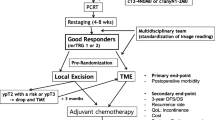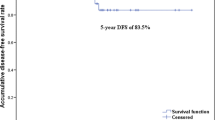Abstract
Purpose
The purpose of this study is to assess if local excision (LE) could be proposed if suspicion of complete tumor response (CR) after neoadjuvant chemoradiotherapy (CRT) for low rectal cancer (LRC) and this despite a potential risk of nodes (N+) or other tumor deposits (OTD) left in place. The aim was to assess in patients with LRC treated by CRT: (a) pathologic results of LE and total mesorectal excision (TME) in case of preoperative suspicion of CR and (b) the risk of N+ or OTD on TME if ypT0-Tis-T1 tumor.
Patients
Among 202 patients with LRC after CRT, 33 (16 %) with suspicion of CR underwent LE (n = 20) because of comorbidities and/or indication of definitive stoma or TME (n = 13). Pathologic examination of LE and TME specimens and oncological outcomes were assessed. Furthermore, 40/202 patients with pathologic CR on TME specimen (ypT0-Tis-T1) were assessed for possible N+ or OTD.
Results
In the 33 patients with suspicion of CR: (a) after LE, tumor was ypT0-Tis-T1 in only 15/20 cases (75 %); (b) after TME, tumor was ypT0-Tis-T1 in only 7/13 cases (54 %). Among 40 patients with ypT0-Tis-T1 tumor on TME specimen, 4 (10 %) presented N+ and/or OTD.
Conclusion
In LRC with suspicion of CR after CRT, LE deserves a word of caution: 25 % of patients have in fact ypT2-T3 tumors. Furthermore, in patients with ypT0-Tis or T1 on TME specimen, a 10 % risk of N+ and/or ODT is observed. Thus, patient with suspicion of CR after CRT and treated by LE is exposed to a possible incomplete oncologic treatment.
Similar content being viewed by others
References
Heald RJ, Husband EM, Ryall RD (1982) The mesorectum in rectal cancer surgery—the clue to pelvic recurrence? Br J Surg 69:613–616
Kapiteijn E, Marijnen CA, Nagtegaal ID et al (2001) Preoperative radiotherapy combined with total mesorectal excision for resectable rectal cancer. N Engl J Med 345:638–646
Bosset JF, Collette L, Calais G et al (2006) Chemotherapy with preoperative radiotherapy in rectal cancer. N Engl J Med 355:1114–1123
Gerard JP, Conroy T, Bonnetain F et al (2006) Preoperative radiotherapy with or without concurrent fluorouracil and leucovorin in T3-4 rectal cancers: results of FFCD 9203. J Clin Oncol 24:4620–4625
Habr-Gama A, Perez RO, Kiss DR et al (2004) Preoperative chemoradiation therapy for low rectal cancer. Impact on downstaging and sphincter-saving operations. Hepatogastroenterology 51:1703–1707
Chau A, Maggiori L, Debove C et al (2014) Toward the end of abdominoperineal resection for rectal cancer? An 8-year experience in 189 consecutive patients with low rectal cancer. Ann Surg 260:801–806
Rullier E (2007) Local excision in downstaged rectal cancer (GRECCAR 2) May 7, 2014., Available at: https://clinicaltrials.gov/ct2/show/NCT00427375. Accessed February 15, 2015
Lezoche G, Baldarelli M, Guerrieri M et al (2008) A prospective randomized study with a 5-year minimum follow-up evaluation of transanal endoscopic microsurgery versus laparoscopic total mesorectal excision after neoadjuvant therapy. Surg Endosc 22:352–358
Kennelly RP, Heeney A, White A et al (2012) A prospective analysis of patient outcome following treatment of T3 rectal cancer with neo-adjuvant chemoradiotherapy and transanal excision. Int J Colorectal Dis 27:759–764
Hanly AM, Ryan EM, Rogers AC et al (2014) Multicenter Evaluation of Rectal cancer ReImaging pOst Neoadjuvant (MERRION) therapy. Ann Surg 259:723–727
Guillem JG, Ruby JA, Leibold T et al (2013) Neither FDG-PET nor CT can distinguish between a pathological complete response and an incomplete response after neoadjuvant chemoradiation in locally advanced rectal cancer: a prospective study. Ann Surg 258:289–295
Kim DW, Kim DY, Kim TH et al (2006) Is T classification still correlated with lymph node status after preoperative chemoradiotherapy for rectal cancer? Cancer 106:1694–1700
Mignanelli ED, de Campos-Lobato LF, Stocchi L et al (2010) Downstaging after chemoradiotherapy for locally advanced rectal cancer: is there more (tumor) than meets the eye? Dis Colon Rectum 53:251–256
Pucciarelli S, Capirci C, Emanuele U et al (2005) Relationship between pathologic T-stage and nodal metastasis after preoperative chemoradiotherapy for locally advanced rectal cancer. Ann Surg Oncol 12:111–116
Bujko K, Nowacki MP, Nasierowska-Guttmejer A et al (2005) Prediction of mesorectal nodal metastases after chemoradiation for rectal cancer: results of a randomised trial: implication for subsequent local excision. Radiother Oncol 76:234–240
Perez RO, Habr-Gama A, Sao Juliao GP et al (2011) Transanal endoscopic microsurgery for residual rectal cancer after neoadjuvant chemoradiation therapy is associated with significant immediate pain and hospital readmission rates. Dis Colon Rectum 54:545–551
Maggiori L, Bretagnol F, Aslam MI et al (2014) Does pathologic response of rectal cancer influence postoperative morbidity after neoadjuvant radiochemotherapy and total mesorectal excision? Surgery 155:468–475
Kanso F, Maggiori L, Debove C, et al. Perineal or abdominal approach first during intersphincteric resection for low rectal cancer: which is the best strategy? Dis Colon Rectum. 2015:[Accepted, In Press].
Washington MK, Berlin J, Branton P et al (2009) Protocol for the examination of specimens from patients with primary carcinoma of the colon and rectum. Arch Pathol Lab Med 133:1539–1551
Mandard AM, Dalibard F, Mandard JC et al (1994) Pathologic assessment of tumor regression after preoperative chemoradiotherapy of esophageal carcinoma. Clinicopathologic correlations. Cancer 73:2680–2686
von Elm E, Altman DG, Egger M et al (2007) The Strengthening the Reporting of Observational Studies in Epidemiology (STROBE) statement: guidelines for reporting observational studies. Lancet 370:1453–1457
Martin ST, Heneghan HM, Winter DC (2012) Systematic review and meta-analysis of outcomes following pathological complete response to neoadjuvant chemoradiotherapy for rectal cancer. Br J Surg 99:918–928
Habr-Gama A, Sabbaga J, Gama-Rodrigues J et al (2013) Watch and wait approach following extended neoadjuvant chemoradiation for distal rectal cancer: are we getting closer to anal cancer management? Dis Colon Rectum 56:1109–1117
Heald RJ, Beets G, Carvalho C (2014) Report from a consensus meeting: response to chemoradiotherapy in rectal cancer—predictor of cure and a crucial new choice for the patient: on behalf of the Champalimaud 2014 Faculty for ‘Rectal cancer: when NOT to operate’. Colorectal Dis 16:334–337
Glynne-Jones R, Hughes R (2012) Critical appraisal of the ‘wait and see’ approach in rectal cancer for clinical complete responders after chemoradiation. Br J Surg 99:897–909
Lezoche E, Baldarelli M, Lezoche G et al (2012) Randomized clinical trial of endoluminal locoregional resection versus laparoscopic total mesorectal excision for T2 rectal cancer after neoadjuvant therapy. Br J Surg 99:1211–1218
Garcia-Aguilar J, Shi Q, Thomas CR Jr et al (2012) A phase II trial of neoadjuvant chemoradiation and local excision for T2N0 rectal cancer: preliminary results of the ACOSOG Z6041 trial. Ann Surg Oncol 19:384–391
Rullier E, Rouanet P, Michot F et al (2013) Local versus rectal excision in downstaged low rectal cancer after radiochemotherapy: preliminary results of the randomized GRECCAR 2 trial. Colorectal Dis 15:4–12
Yeo SG, Kim DY, Kim TH et al (2010) Pathologic complete response of primary tumor following preoperative chemoradiotherapy for locally advanced rectal cancer: long-term outcomes and prognostic significance of pathologic nodal status (KROG 09–01). Ann Surg 252:998–1004
Park IJ, You YN, Skibber JM et al (2013) Comparative analysis of lymph node metastases in patients with ypT0-2 rectal cancers after neoadjuvant chemoradiotherapy. Dis Colon Rectum 56:135–141
Smith FM, Wiland H, Mace A et al (2014) Clinical criteria underestimate complete pathological response in rectal cancer treated with neoadjuvant chemoradiotherapy. Dis Colon Rectum 57:311–315
Verseveld M, de Graaf EJR, Verhoef C et al (2015) Chemoradiation therapy for rectal cancer in the distal rectum followed by organ-sparing transanal endoscopic microsurgey (CARTS study). Br J Surg 102:853–860
Stipa F, Picchio M, Burza A et al (2014) Long-term outcome of local excision after preoperative chemoradiation for ypT0 rectal cancer. Dis Colon Rectum 57:1245–1252
Lee NK, Kim DY, Kim SY et al (2014) Clinical outcomes of local excision following preoperative chemoradiotherapy for locally advanced rectal cancer. Cancer Res Treat 46:158–164
Piessen G, Cabral C, Benoist S et al (2012) Previous transanal full-thickness excision increases the morbidity of radical resection for rectal cancer. Colorectal Dis 14:445–452
Lefevre JH, Rousseau A, Svrcek M et al (2013) A multicentric randomized controlled trial on the impact of lengthening the interval between neoadjuvant radiochemotherapy and surgery on complete pathological response in rectal cancer (GRECCAR-6 trial): rationale and design. BMC Cancer 13:417
Petrelli F, Sgroi G, Sarti E, et al. Increasing the Interval Between Neoadjuvant Chemoradiotherapy and Surgery in Rectal Cancer: A Meta-Analysis of Published Studies. Ann Surg. 2013.
Author information
Authors and Affiliations
Corresponding author
Ethics declarations
The authors declare that they have no conflict of interest.
Rights and permissions
About this article
Cite this article
Debove, C., Guedj, N., Tribillon, E. et al. Local excision of low rectal cancer treated by chemoradiotherapy: is it safe for all patients with suspicion of complete tumor response?. Int J Colorectal Dis 31, 853–860 (2016). https://doi.org/10.1007/s00384-016-2546-1
Accepted:
Published:
Issue Date:
DOI: https://doi.org/10.1007/s00384-016-2546-1




